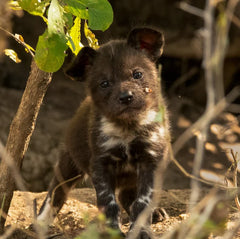
The Plight Of The African Wild Dog

Painted Perfection....
Imagine a kaleidoscope come to life, dashing across the African savanna. In a nutshell….. that’s the African wild dog.
This stunning canine has a coat that is a masterpiece of mismatched browns, blacks and whites with the occasional splash of yellow. These amazing dogs, also known as "painted dogs," are Africa's most successful predators, boasting an impressive 80% hunting success rate!
But the sobering truth is that these vibrantly social creatures are facing extinction.
Let's delve into the fascinating world of the African wild dog and understand why protecting them is more crucial than ever.
Pack Mentality with a Twist
Unlike your average canine companion, the African wild dog is all about the pack. Most dog packs are led by an alpha male, the wild dog packs function pretty much as a cooperative democracy. The breeding pair in the pack is a monogamous couple and they take the lead. Their hunting strategies and pup care however, is a communal effort.
These packs can have up to 40 members so just imagine a game of fetch with so many furry friends, and one can easily be tempted as wild dog pups are ridiculously cute, with floppy ears and boundless energy.

They spend their days playing with each other, for fun and games but their play is aimed at honing their hunting skills for the future.
Born to Run, Built to Outlast
Usain Bolt has nothing on these beauties. They are lean, agile hunters and can reach a speed of up to 70km (44 miles) per hour! Their unique build, with large round ears and a powerful chest, is all about endurance. Unlike other hunters, they don't rely on brute force to take down prey, instead they chase their targets relentlessly, wearing them down in a hot pursuit that can last for over an hour.
Interesting fact.
Unlike most canines who have five toes on each foot, wild dogs have only four toes on each foot. This actually helps them be more efficient runners and is of no disadvantage at all.
Their Cooperation is a true symphony.
While the lion, king of the jungle might be a majestic sight, there's something undeniably beautiful about the coordinated dance of a wild dog hunt. These pack hunters rely on remarkable teamwork and relentless pursuit. Some members flush out the prey, while others take turns nipping at the heels of the fleeing animal, slowly sapping its strength. Communication is key, and wild dogs use a complex vocabulary of barks, whines, and growls to strategize and keep the pack in sync. They have an amazing 80% success rate making them one of the most effective hunters in Africa
Fun Fact.
A "sneeze" or series of "sneezes" may determine the start of the hunt. According to a recent study by the Royal Society, the rapid exhale or a "sneeze" by one pack member, followed by the "sneezes" of pack members, seemed to indicate the pack's readiness to head off.
Excerpt from https://royalsocietypublishing.org/doi/full/10.1098/rspb.2017.0347
The Fight for Survival
This vibrant symphony of nature is sadly facing a severe decline in numbers. The African wild dog is listed as endangered, and with very good reason.

There are close to eight billion people populating the globe and fewer than 5,000 African Wild Dogs (650 breeding pairs), and if this statement doesn’t serve as a “shock and awe” tactic, then you are not taking this serious enough. When a population of any animal gets too small and is no longer sustainable because there aren’t enough of individuals left to formulate a healthy gene pool, there is no return.
Most males will remain in their natal pack throughout their lives. Females between 14 and 30 months of age leave their natal pack in groups of littermate sisters and form a new pack with an unrelated pack of a group of related males.
An alpha female typically gives birth to 10 to 12 pups per litter with some litter sizes up to 21 pups, the most of any dog.

She gives birth to these pups in a den, typically an underground burrow of another animal, such as a warthog.
Having so many pups sounds rather glorious, but there are very real threats that contribute to the decline of their population numbers.
The Not-So-Pretty Side.
Now, for the part that tugs at our heartstrings......
Let’s look at the real reasons why these beauties numbers are diminishing.
Habitat loss due to human encroachment is a major threat to African wild dogs.
As human populations grow, their need for land for agriculture, settlements and roads increases, which reduces suitable habitat for the wild dogs and their prey.

This fragmentation restricts their roaming grounds and pushes them into closer contact with humans. Confined to smaller areas, wild dogs struggle to find enough prey and are more likely to encounter humans, leading to conflict as farmers who lose livestock to wild dog predation retaliate by poisoning or shooting them. They are also injured and killed in snares as well as road kills as they encroach on human territory.
https://www.wildlifevetsinternational.org/projects/african-painted-dogs

Additionally, with increased contact with domestic dogs, wild dogs become susceptible to deadly diseases like rabies and canine distemper.These diseases can spread rapidly through packs and wipe out entire packs at a time, devastating to their populations.
Good News……..
But here's the good news and there is still hope! Conservation efforts are taken seriously by organizations to protect these magnificent creatures.

The Beauty Of The African Wild Dog - Photo By National Geographic
They are working hard to create wildlife corridors, educate communities about the importance of wild dogs, and even use innovative techniques like vaccination programs to combat disease.
One of these organizations is Painted Dog Conservation Inc., and they do very amazing work to bring change to the dire situation of these incredible painted beauties. Please check out the link below to get more information about their passion and their amazing work to make a difference.
A visit to their FB page will also give you a very good idea of what they’re up to and how much they care.
https://www.facebook.com/pdcincaustralia/
How You Can Help "Paint" a Brighter Future
So, what can you do to help?
Even small actions can make a big difference. You can support reputable conservation organizations working to protect wild dogs.
Spreading awareness and educating others about these amazing creatures is imperative and WILL make a difference in the long run, so please get involved in some way before time "outruns" us.
The more people who know about the plight of the African wild dog, the stronger the voice for their survival.

The African wild dog is a symbol of resilience, teamwork, and a living testimony to the raw beauty and complexity of nature. Let's work together to ensure these painted masterpieces continue to grace the African savanna for generations to come.
Remember, even a small paw print can leave a big mark in the fight for conservation!
